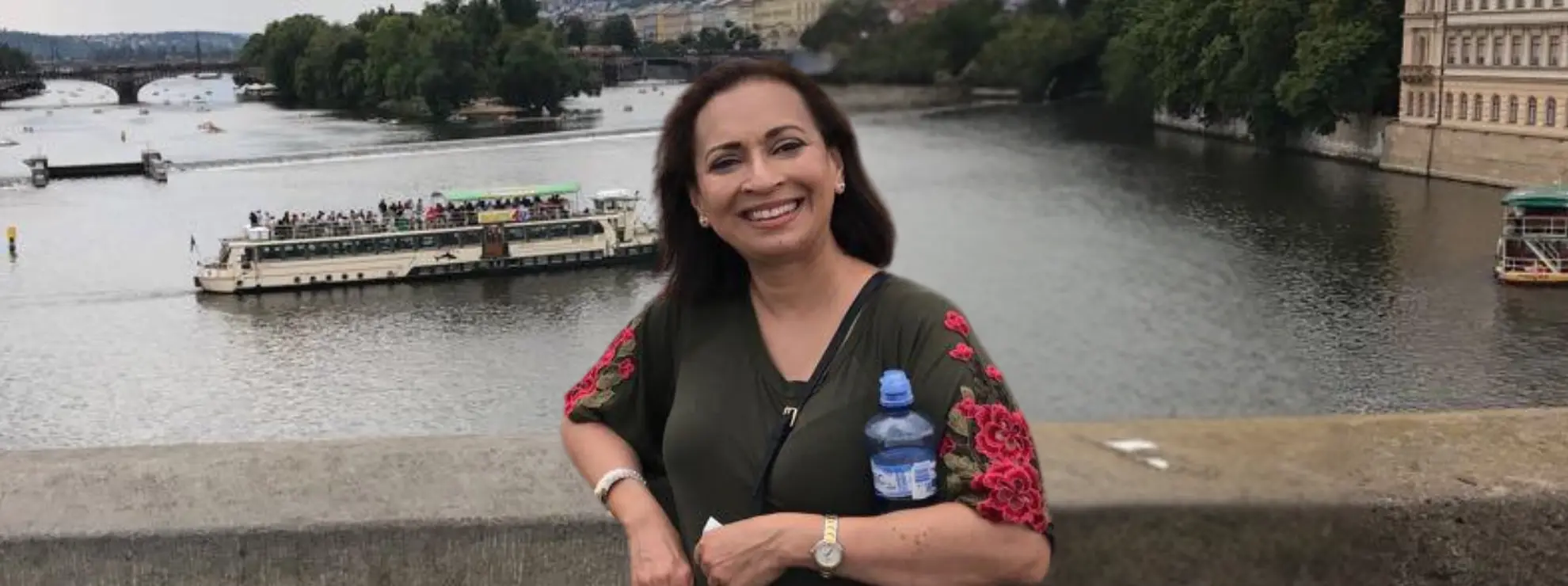(November 29, 2024) Back in 1985, when Priya Arora got into Oxford University to earn a degree in English literature, she never imagined that decades later, the critical thinking skills she developed during the three-year course — would come handy for a better understanding of the Ramayana.
Learning through research and analysis at the prestigious institution was another plus point. It’s precisely these skill sets which help her a great deal in her current role as an author and all other endeavours. “The skills I learned at Oxford helped me provide the context and reasoning behind some of the controversial episodes in Ramayana. Additionally, I was also able to view various situations in the epic based on the teachings of the Upanishads that the story dramatises,” smiles author, survivor, and devoted spiritual seeker Priya Arora, in conversation with Global Indian.
A resident of the San Francisco Bay area in the United States, Priya recently released a compelling retelling of Valmiki’s Ramayana through the biography of Raja Rama, titled Rama: A Man of Dharma (Penguin India).

Priya Arora
Vedic philosophy
“The book is the result of my spiritual journey that began about 12 years ago when I attended a lecture on the Bhagavad Gita at the Ramakrishna Mission in Berkeley,” informs Priya. The talk sparked her interest in the ancient Vedic shastras and set her on a path of learning. It led her to the profundity of Vedic philosophy, its inclusiveness, and importantly, Vedanta’s fundamental teaching of the unity of spirit.
Initially, she began studying the Shastras in English with the help of translations, but soon realized that loss of meaning is real, no matter how good a translation may be. “To relate to the texts directly, I embarked on learning Sanskrit through Samskrita Bharati and Vyoma—Sanskrit from Home, two incredible organizations dedicated to teaching Sanskrit,” says the author, while drawing attention to the fact that Sanskrit is the mother of most world languages and has perfect grammar, enormous depth of expression, and an endless vocabulary.
Early life in India
Born in Chennai in the 1960s, Priya is the daughter of Deba Prasad Barua and Kamini Barua. Her father retired as Finance Director of ITC. The family moved to Kolkata when Priya was five. There, she studied at Modern High School and then went to St Xavier’s college.
Academically, she was a reasonably good student, especially in life sciences like biology. In high school, she took subjects that would enable her to pursue a career in medicine, but she changed her mind and went in the opposite direction with English Literature instead.

Rama: A Man of Dharma, is scheduled for international release in February 2025
Back in the day, Priya’s grandparents had a dairy farm in Bengaluru where she would spend the entire summer holidays tending to the cows. An animal lover since childhood, she would use her pocket money to buy birds and set them free.
Priya’s eyes light up as she recalls her days at Oxford. “The University places a premium on critical thinking and analysis, irrespective of the field of study. Instead of being lecture-driven, an Oxford education focuses on small-group tutorials,” she says, adding that the tutorials discuss the student’s perspective and interpretation from different angles.
Oxford University places a premium on critical thinking and analysis, irrespective of the field of study. Instead of being lecture-driven, an Oxford education focuses on small-group tutorials. – Priya Arora
Stint in Citibank
After returning from Oxford, Priya joined Citibank in 1989 when the bank launched credit cards in India. “This was a fantastic work experience. Although the team was young, we were all given huge jobs that required us to to fit demanding roles,” says Priya, who was managing the Western Region service center in Mumbai.
Recalling a funny incident while at Citibank, Priya says an irate customer once demanded to see the manager and was sent to her. “He took one look at me and said he wanted to see my boss. He simply refused to accept that I could be in charge,” laughs Priya, who was in her twenties back then.
She met her future husband, Mohit, at Citibank. The couple moved to the San Francisco Bay Area, USA, in the early 90s. They have two children Tanya and Jay. They are also pet parents to a French Bulldog called Humphrey.
Priya and Mohit own and run an IT services company in San Francisco. She oversees the financial side of the business. Her typical day begins with her puja followed by office work.
The Ramayana for a global audience

Priya says the legendary poet Valmiki composed a biography to showcase the life of an exceptionally principled human being. “I felt it necessary to highlight Rama’s historicity and clear misconceptions and misunderstandings surrounding Rama’s actions and events in Ramayana,” says Priya.
Pointing to the timelessness of the Ramayana, she says Lord Brahma said that Rama’s story would endure as long as there were rivers and mountains on Earth. “Seven thousand years later, the Ramayana continues to be inspirational because it espouses eternal values like equality, fraternity, liberty, equanimity, and selfless action that never lose relevance.”
Storytelling apart, the book showcases the wisdom of India’s ancestors, aligning their values with modern ideals. “The Ramayana is filled with life lessons that benefit us even today. It teaches courage and fortitude to handle problems that are the inevitable result of birth,” says Priya.
This retelling of Valmiki’s Ramayana brings alive the ancient Sanskrit epic in lucid English without diluting the original intent. Making this edition even more special are the additional chapters on Vedic life, Rama’s descendants and the story of Valmiki. “The values we cherish today like democracy, liberty, equality, and justice are at the core of this story,” she informs, adding that Rama embodies righteousness that never loses relevance, making him a man of dharma and a role model in every age.
Being spiritual
For Priya Arora, being spiritual is about going inward to discover the truth of one’s identity. It is about knowing one’s inner essence and reacquainting oneself with who one really is.

She believes spirituality is different from religion. “Religion is more about predefined moral codes and rules of worship and involves following a belief system, whereas spirituality is a personal journey of discovery. A spiritual person is a seeker on a quest to find the truth.”
Priya Arora says a person can be both religious and spiritual, but one can also be religious and not at all spiritual or spiritual and not at all religious. “It is possible to be religious and still do sinful things, but it is impossible to engage in wickedness if one is truly spiritual.”
The survivor story
Life is a mixed bag of joy and sorrow for most people. It has been the same for Priya. She faced two significant challenges — parenting an autistic child with severe OCD and treatment for a particularly aggressive form of cancer.
“My son’s disability consumed me, and it seemed an impossible situation to come to terms with. Vedanta changed my outlook and equipped me with coping skills, so today, I have found the strength to deal with the problem without falling apart,” says Priya.
When hardship comes knocking at the door, it takes on gigantic proportions in the mind. “This tendency is natural, but it exacerbates grief. Practicing detachment can distance us from suffering so the pain is not debilitating,” says the author, who recently attended a 5-day spiritual retreat in Asilomar organized by the Ramakrishna Mission.

India is home
The Arora family visit India often as they not only have their business operations here but also love spending time in their home country. “We used to go on holidays to Europe, East Asia, and Africa, before realizing we had not explored our own land. So, now we make it a point to visit places of interest in India,” says Priya, who visited Gaya and Varanasi last year, which she describes as a wonderful spiritual experience.
In the pipeline
Priya Arora is currently working on a book on Dharma. In 2025, she will be coming up with another book, inspired by the Bhagavad Gita.
“Writing is a recent aspect of my life. It is the medium through which I express my passion for our ancient wisdom,” says Priya, who spends a significant part of the day studying Sanskrit and other literary treasures, including the Upanishads, the Bhagavad Gita, and the Puranas.
She previously enjoyed painting, scrapbooking and Zumba. Now, she is immersed in Vedanta and learning Sanskrit. “I listen to eminent acharyas while doing everyday chores, be it cooking, cleaning, laundry, or driving. It is amazing how much time one can carve out from the day for something one loves.”

- Priya Arora’s books are available on Amazon.
Also Read: Raising the stakes: How investment banker Anurag Tripathi became a bestselling author




